Return to U.S. Space & Rocket Center
F-1 Engine LOX Flow Meter
This exhibit is somewhat unclear, and it took a long time and a fair amount of detective work to determine exactly that it was.
I had not seen or read anything about a "LOX flow meter" until the USSRC added this exhibit in 2009. The artifact left me rather puzzled, due to its size: the LOX turbopump inducer is right behind the LOX inlet closure, so there's no room for the flow meter there. The exhibit has a much larger diameter than the LOX high pressure duct. Both of these facts would have precluded it from being located on the engine proper.
This left me assuming that it must be part of the LOX feed lines in the S-IC stage. On the other hand, the inside diameter of the LOX suction lines as they run through the RP-1 tanks is 20" (reduced to 17" in the thrust structure), so this artifact would seem to be too small to be part of the S-IC LOX system.
In either case, there's no obvious electrical connection; a meter isn't much good if its output can't be measured.
I discussed this artifact with the curator, knowing that this exhibit was added several years before he assumed the position. He, too, was uncertain as what exactly the artifact was or where it would have been located. He suggested that it was plausible that this was a model, but also suggested that it might have been used on a test stand.
Finally, while reading the F-1 Rocket Engine Technical Manual: Engine Data, I found the description of a "LOX flowmeter" (without the space) which is part of the stage pressurization system.
As it turns out, the flowmeter is an instrument much smaller than this display, located in the LOX supply line to the heat exchanger. F-1 Familiarization also has a cut-away diagram of the flowmeter, which is very similar to this artifact (although the actual flight instrument has eight blades on its turbine, rather than the 10 depicted on this artifact).
Eventually, two readers of this Website who have LOX flowmeters in their collections sent photos of their flowmeters, which appear on the above-linked page.
So, then, this is actually a large-scale model of the actual flight instrument.
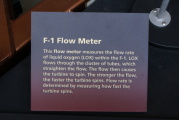 dsc74906.jpg |
 dsc74882.jpg |
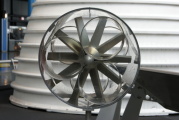 dsc74886.jpg |
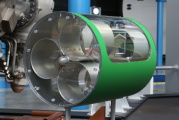 dsc74888.jpg |
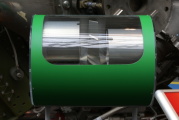 dsc74893.jpg |
 dsc81578.jpg |
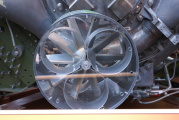 dsc79625.jpg |
 dsc74907.jpg |
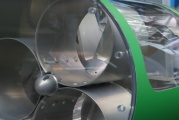 dsc74896.jpg |
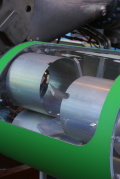 dsc79627.jpg |
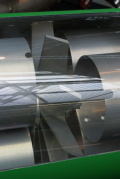 dsc74901.jpg |
 dsc74900.jpg |
 dsc74904.jpg |
Return to U.S. Space & Rocket Center